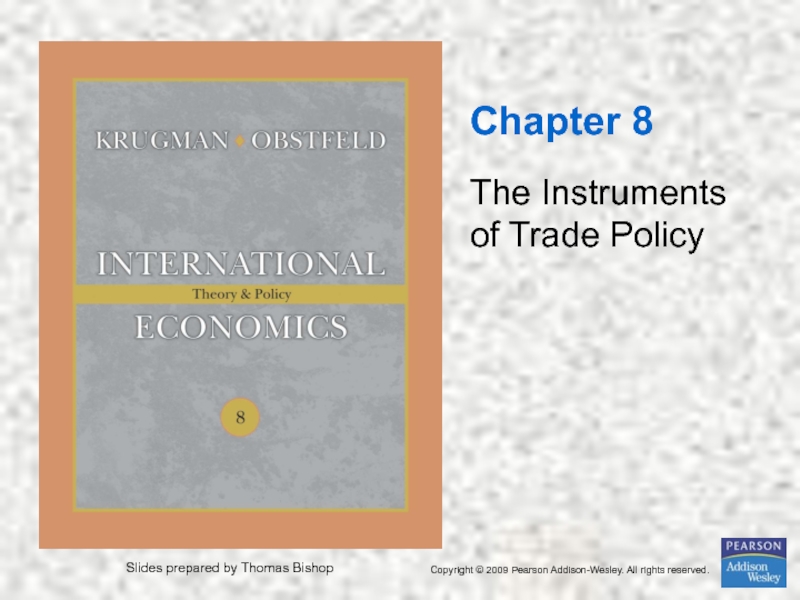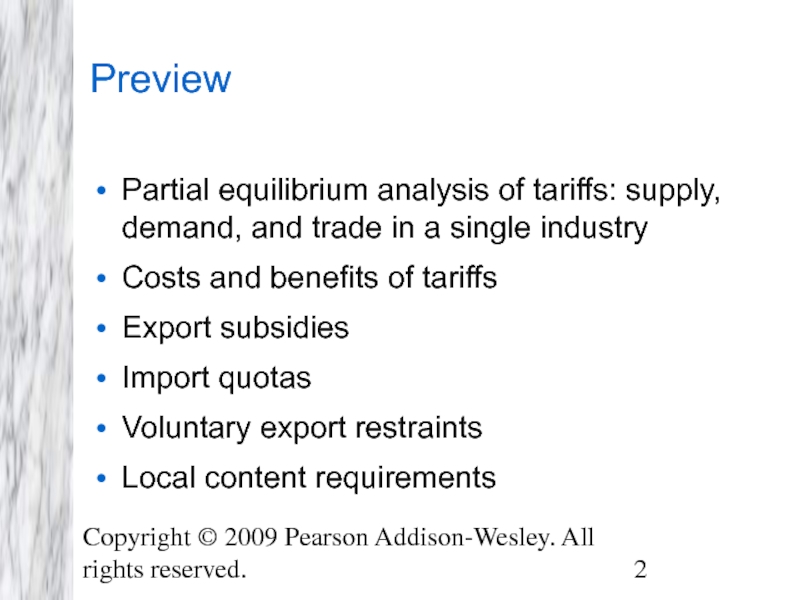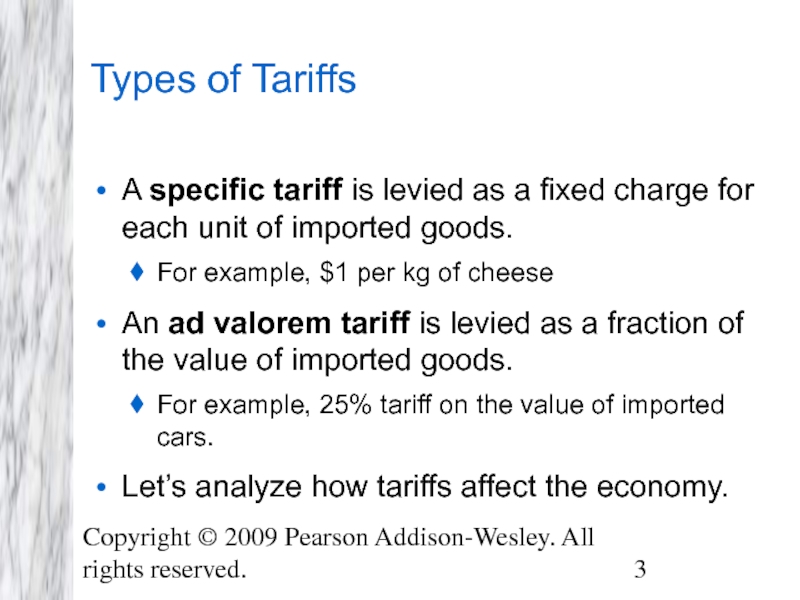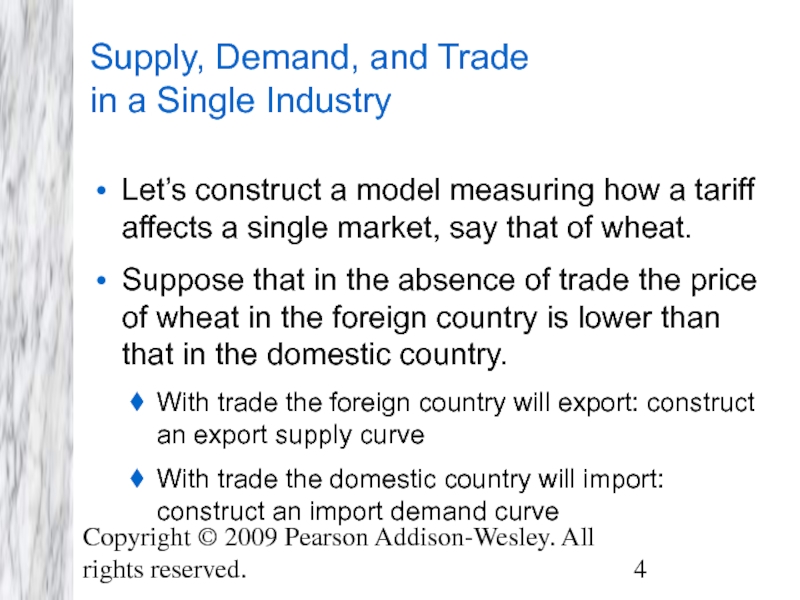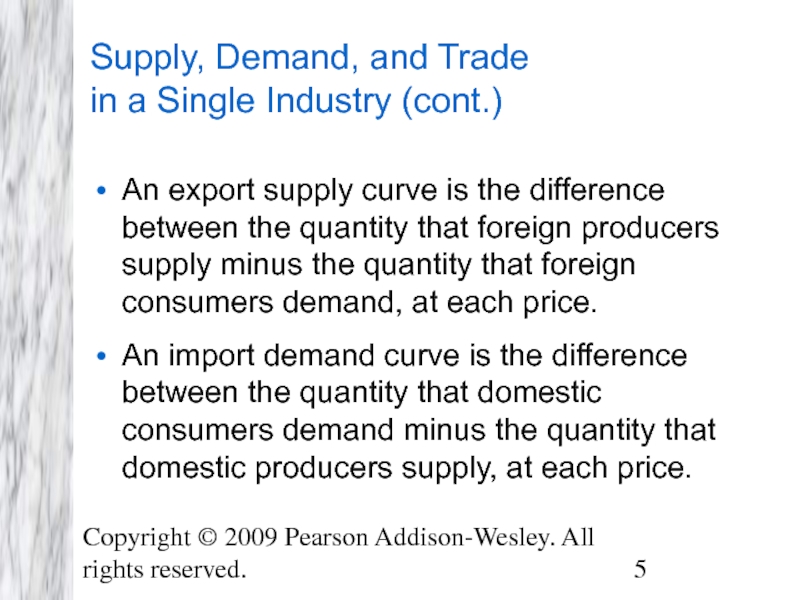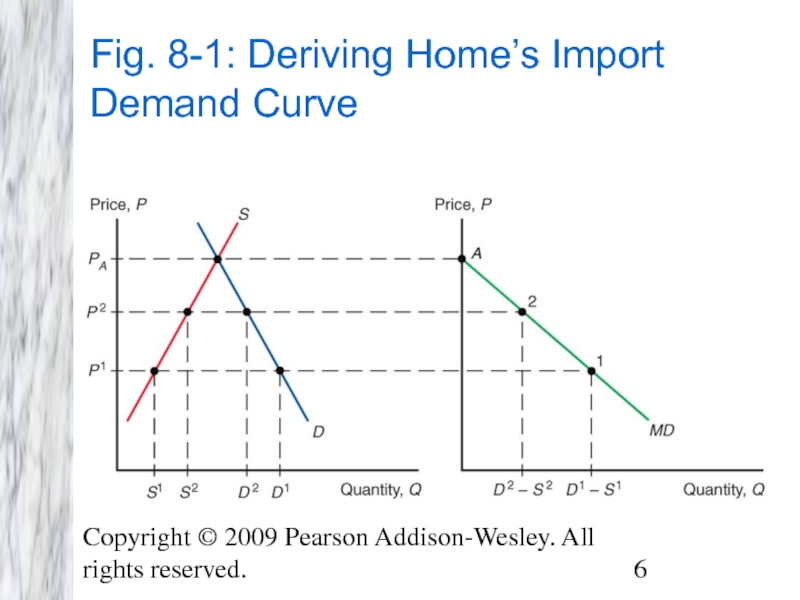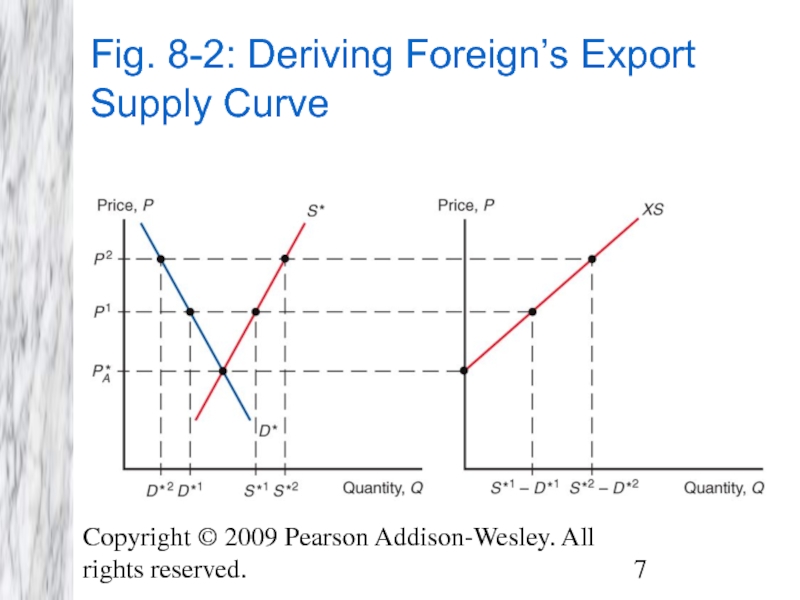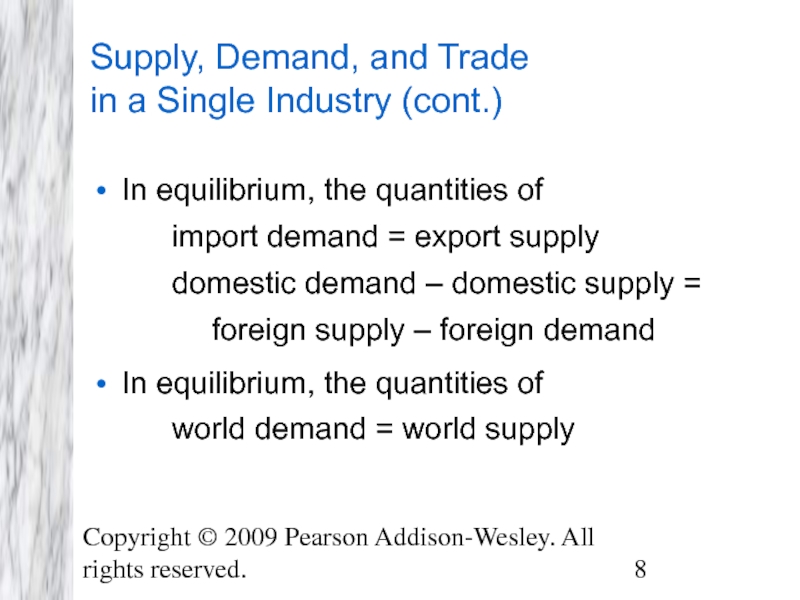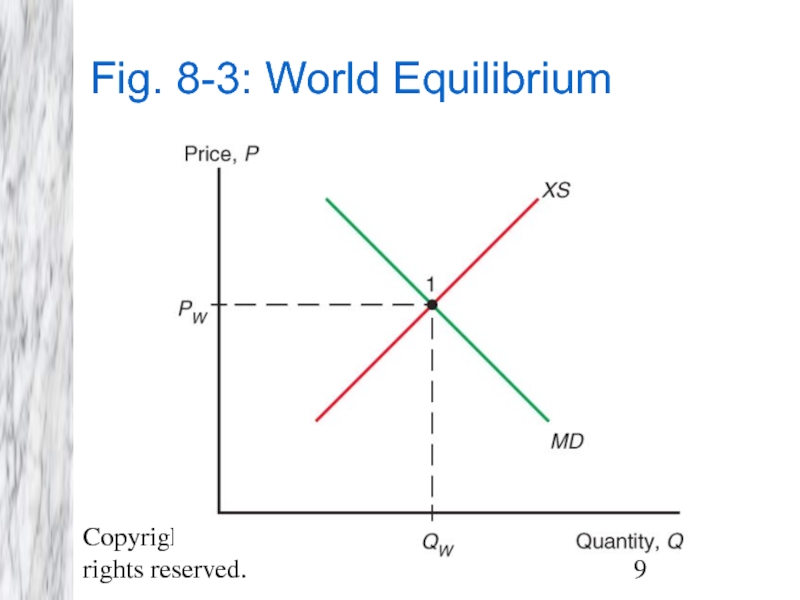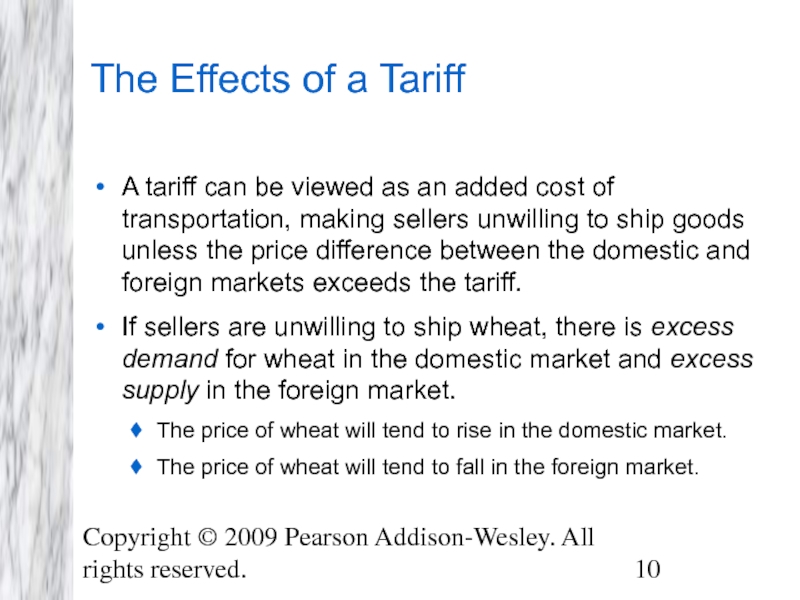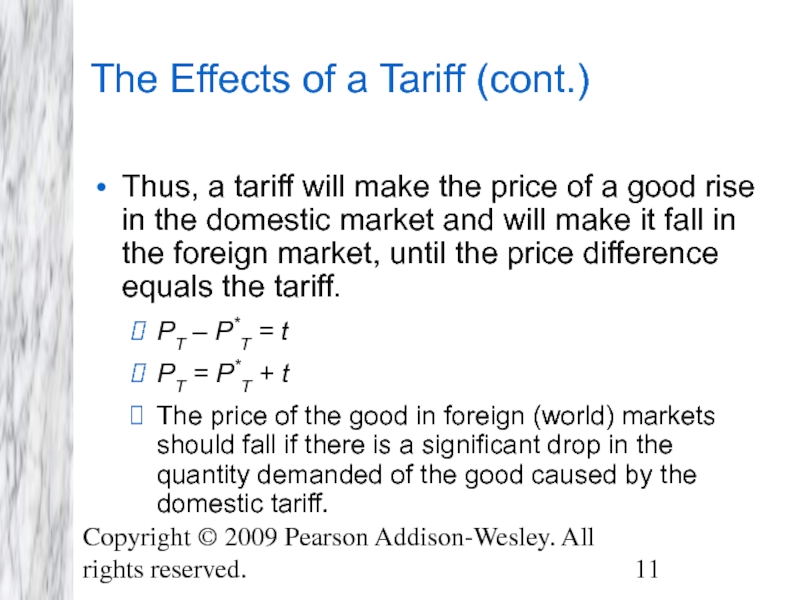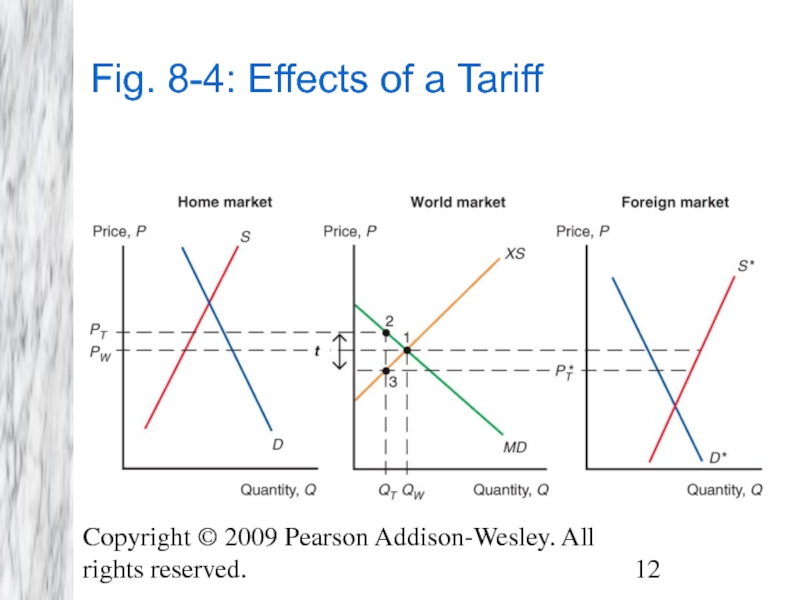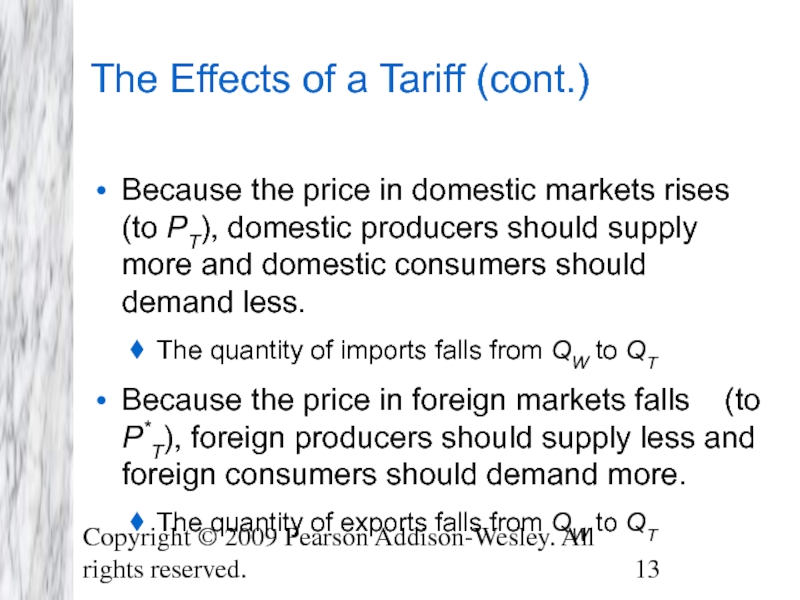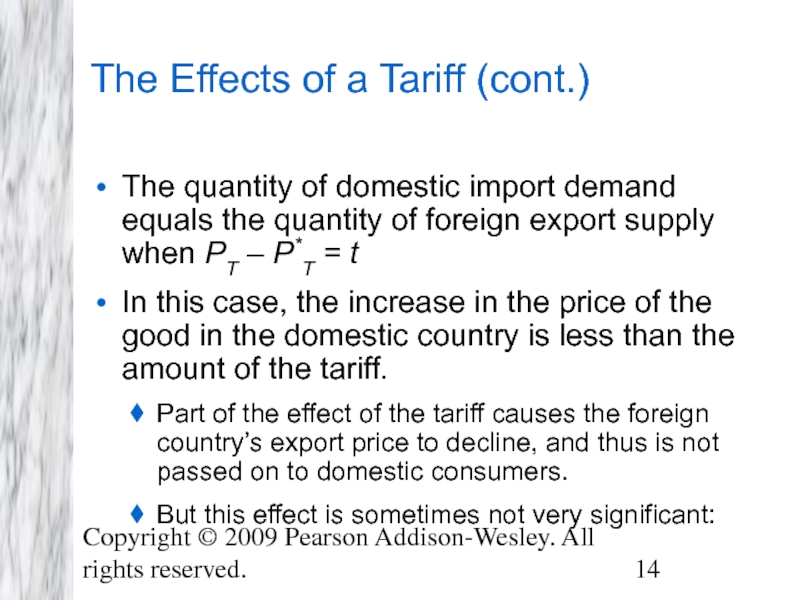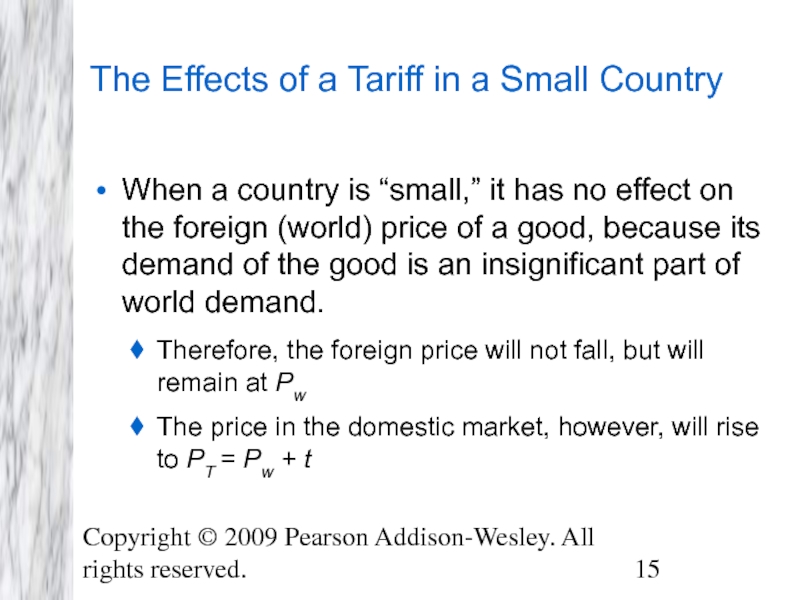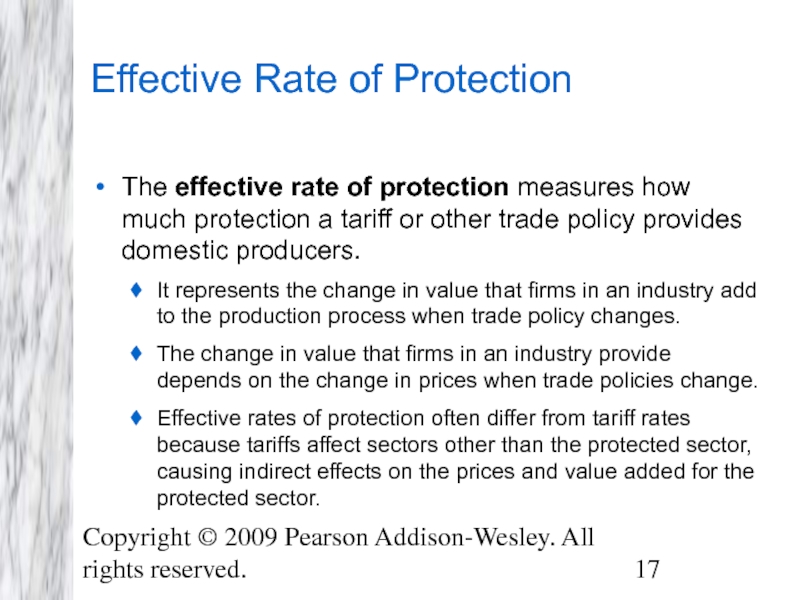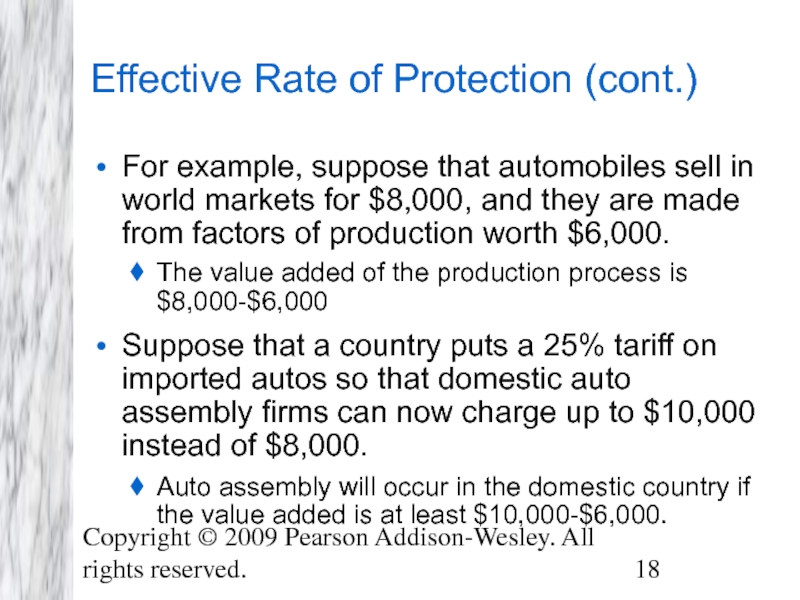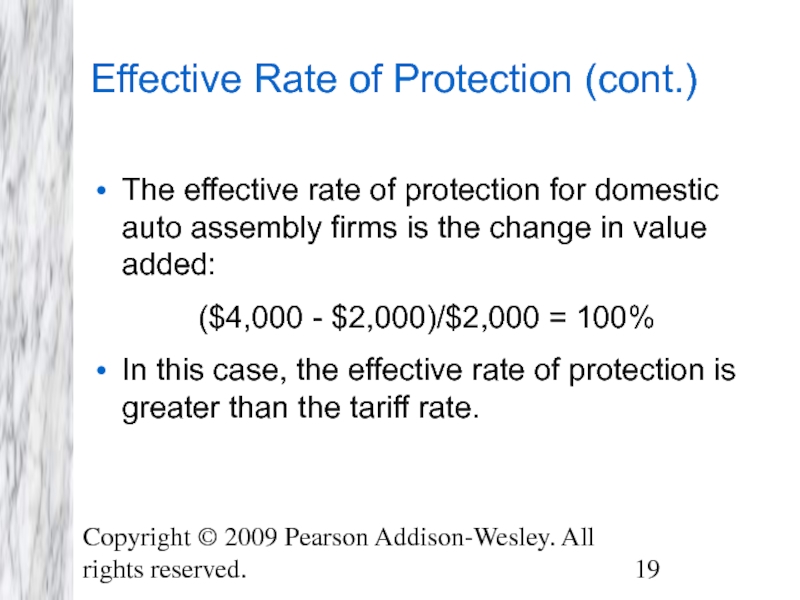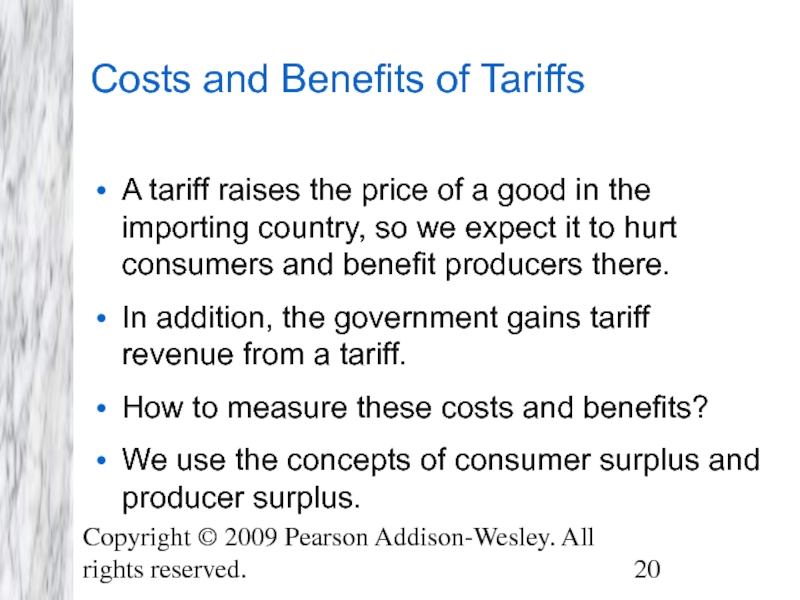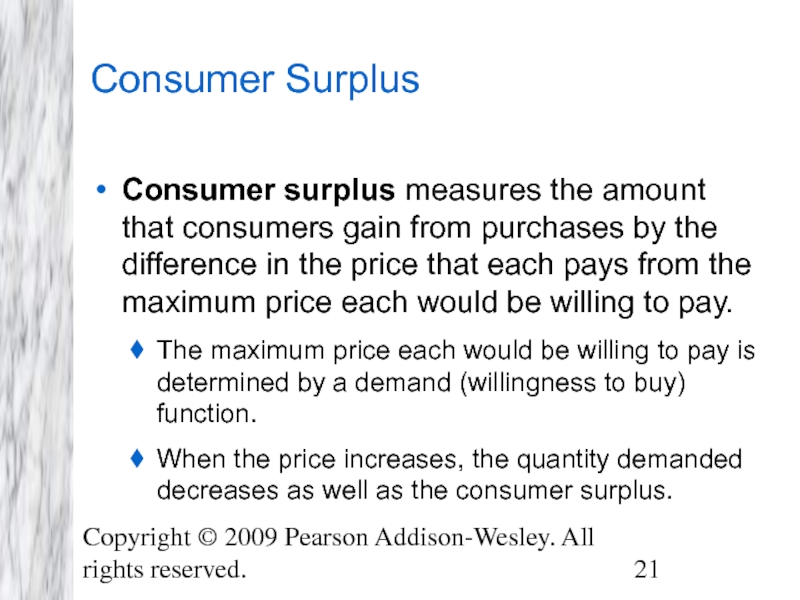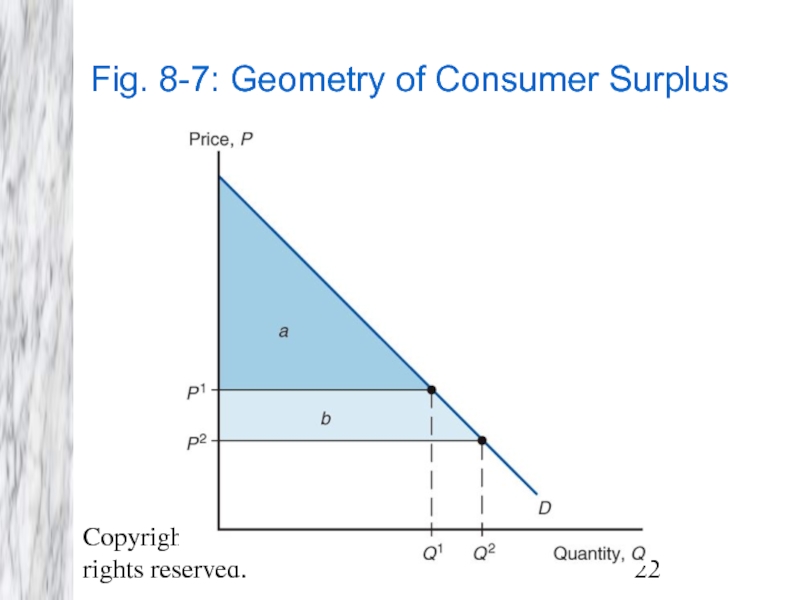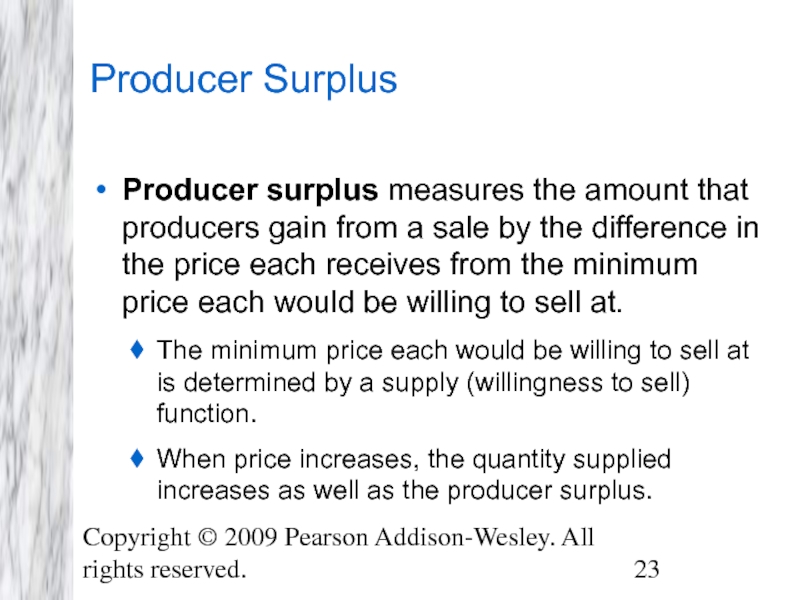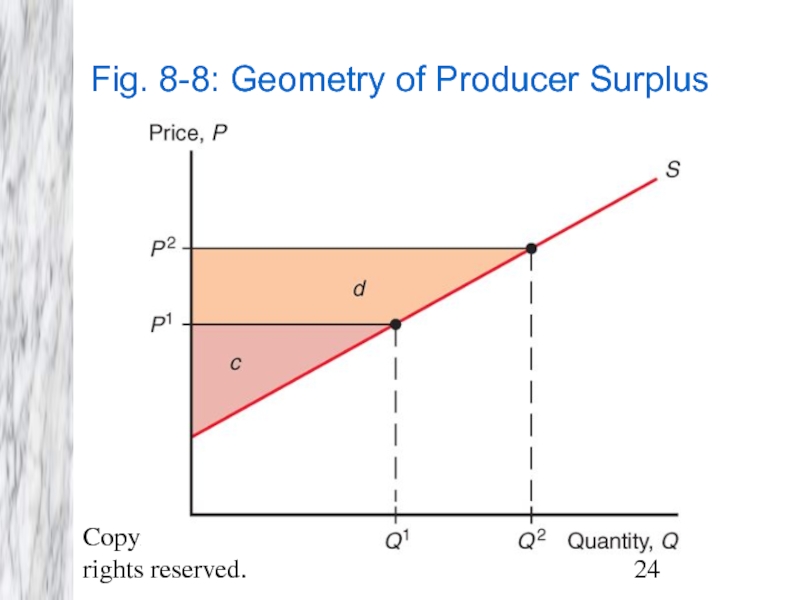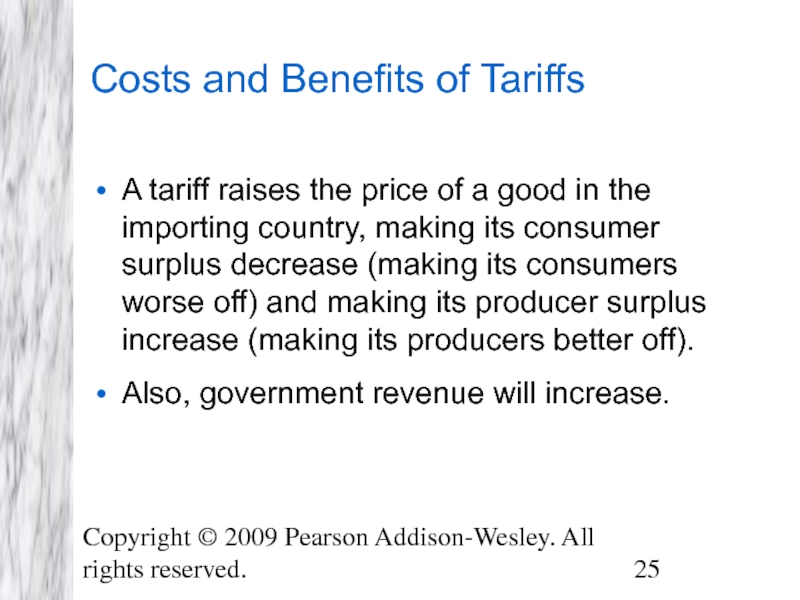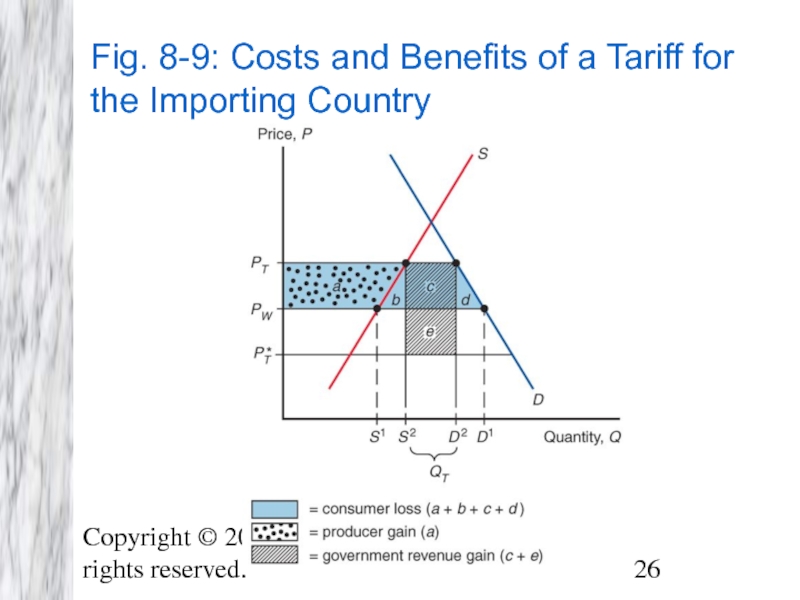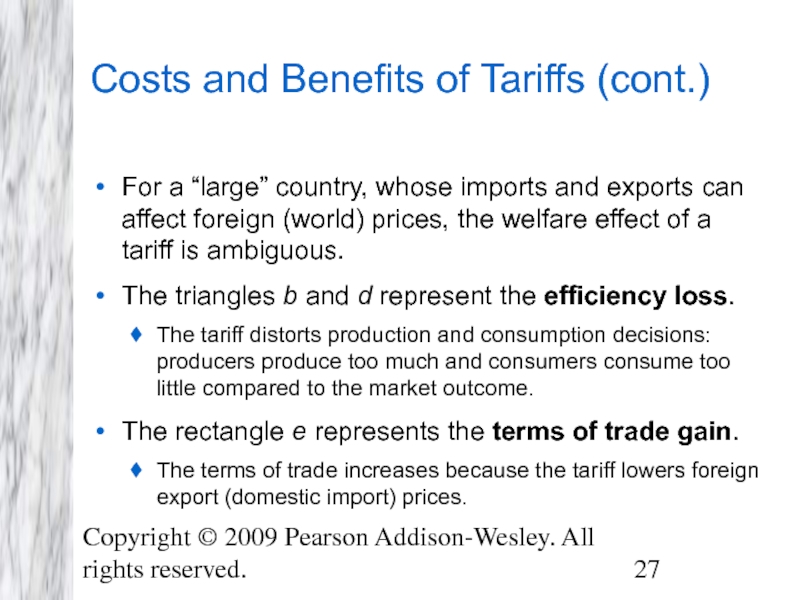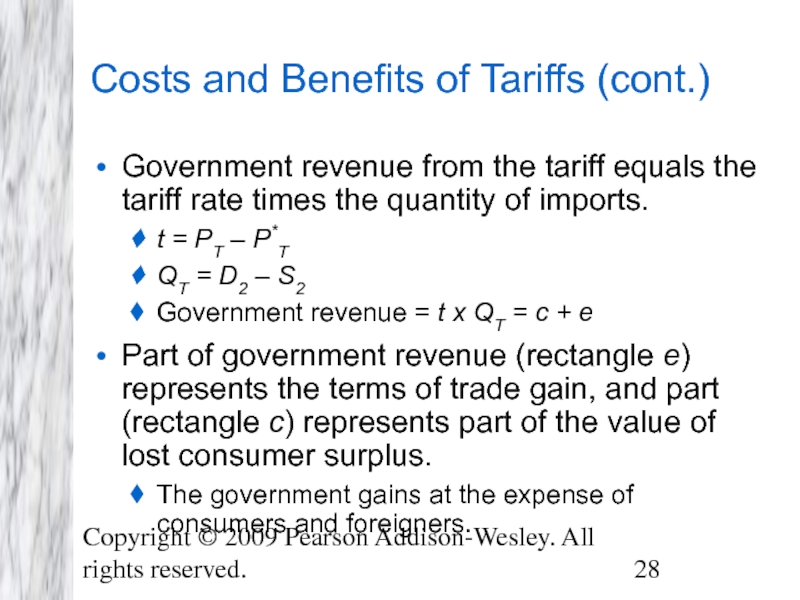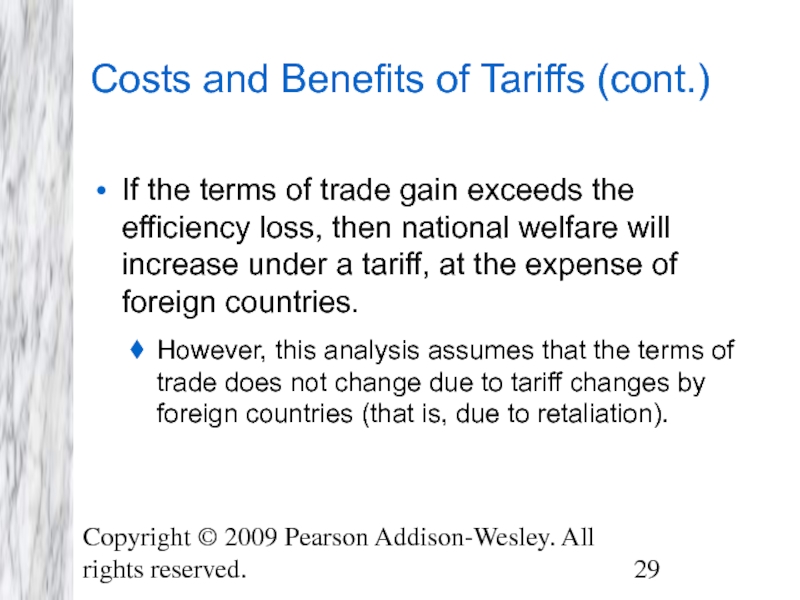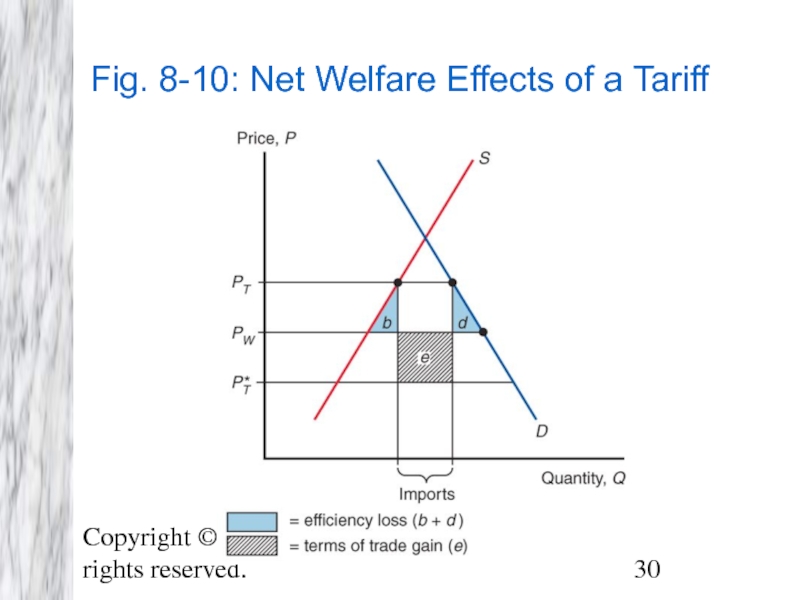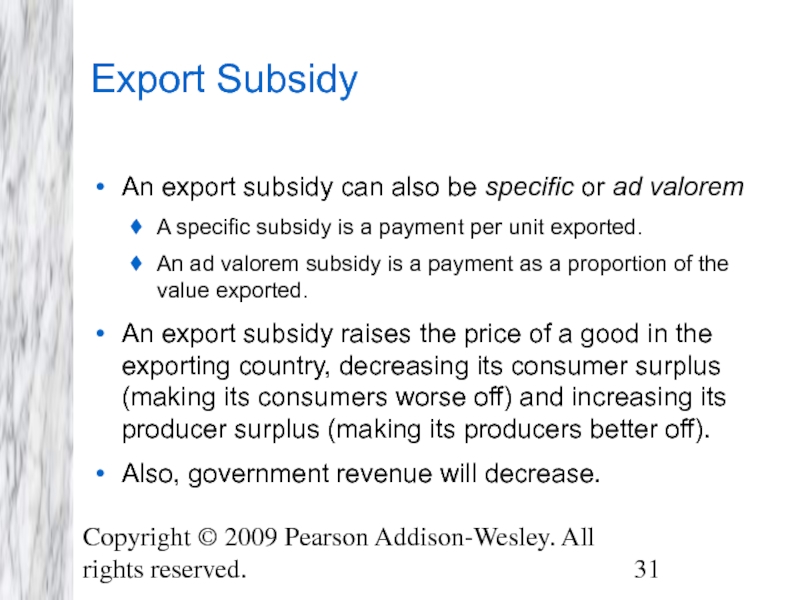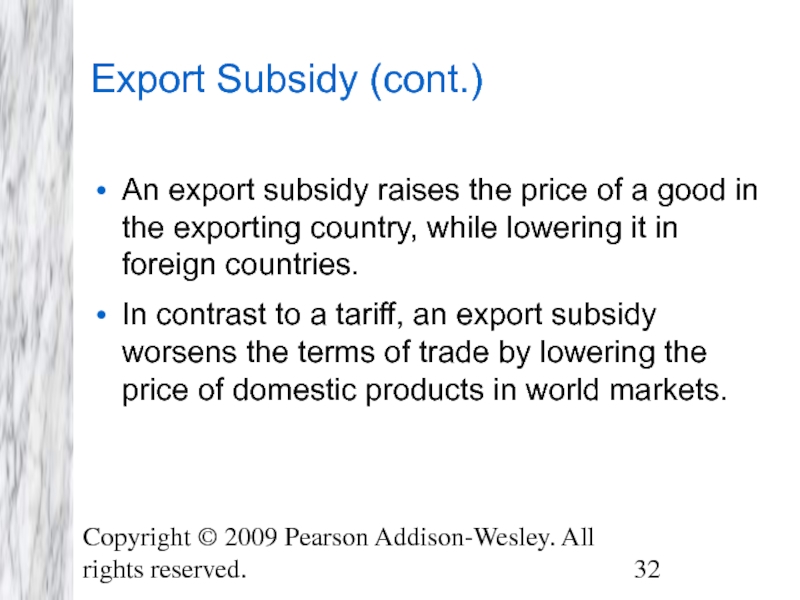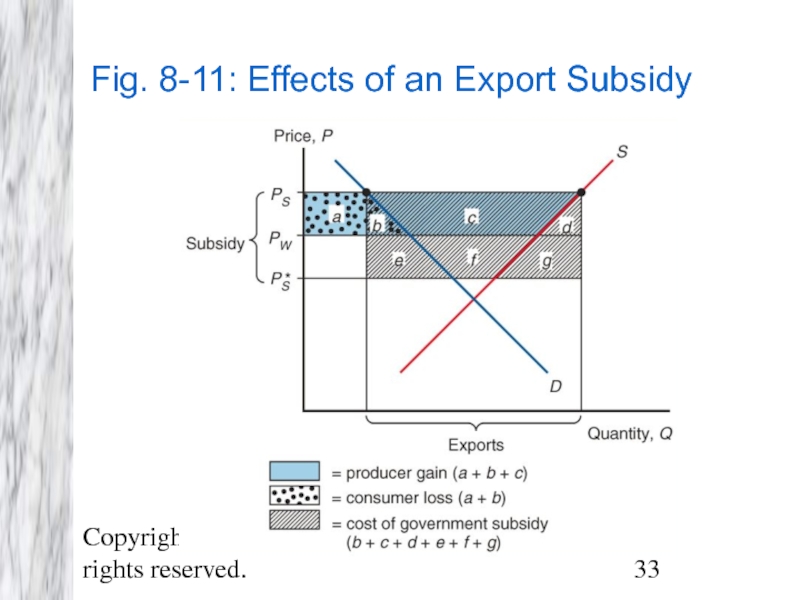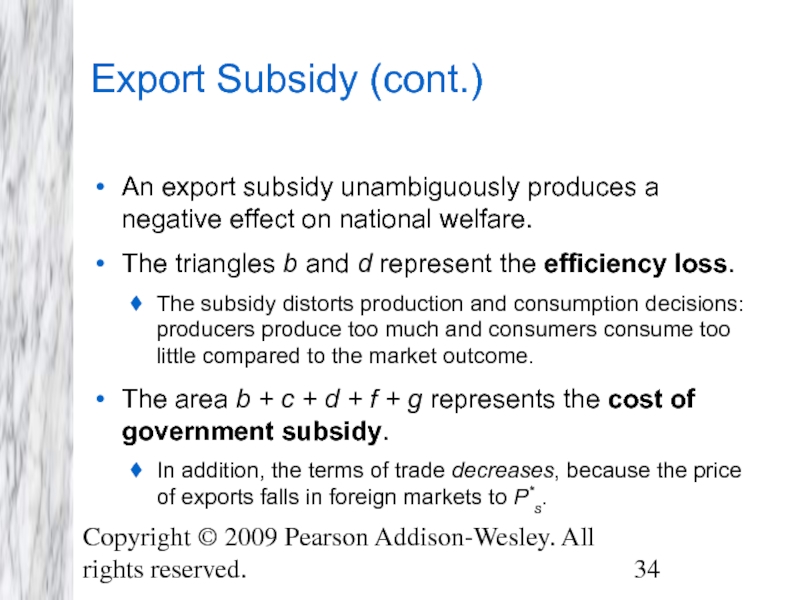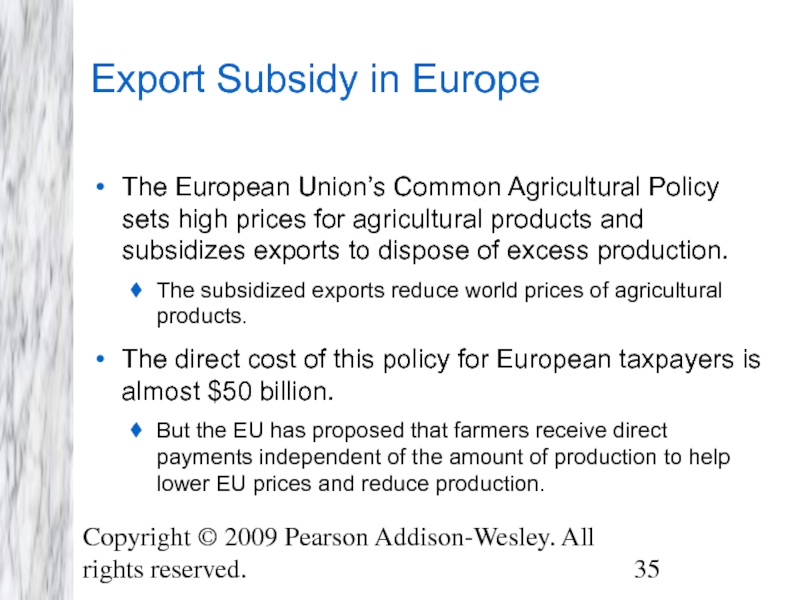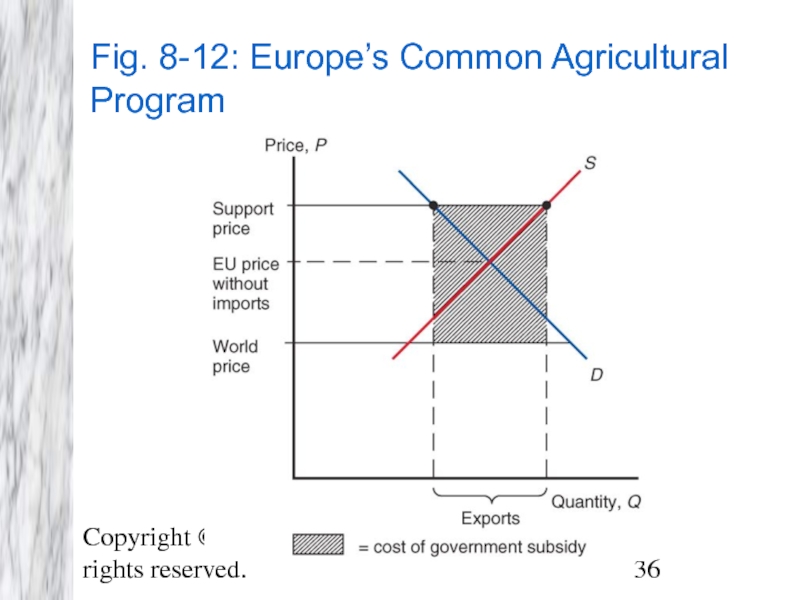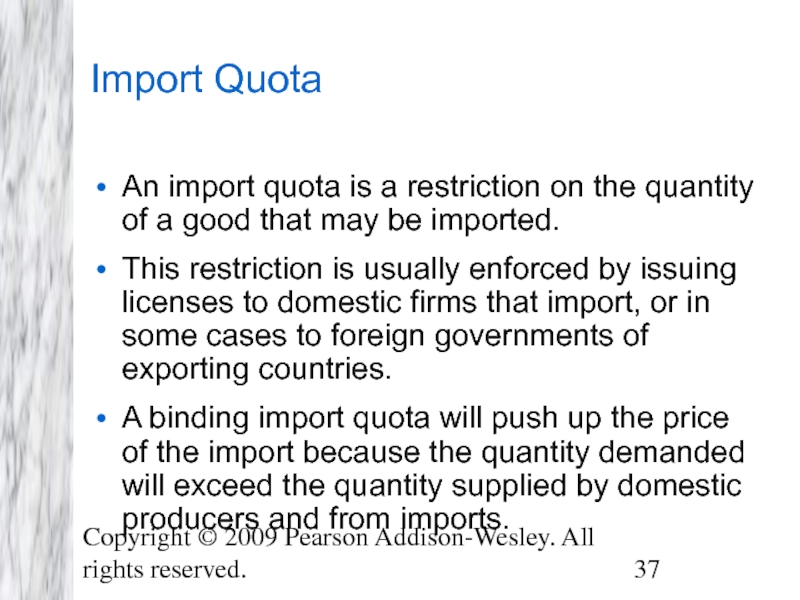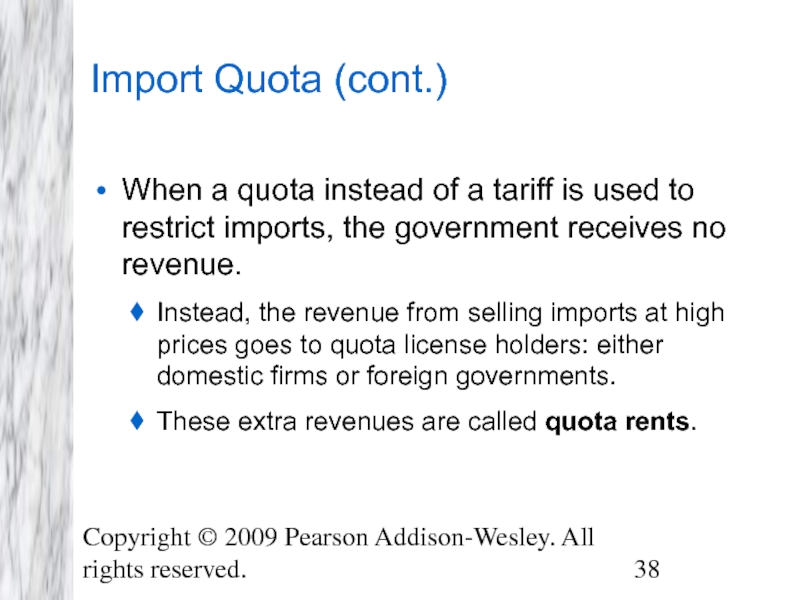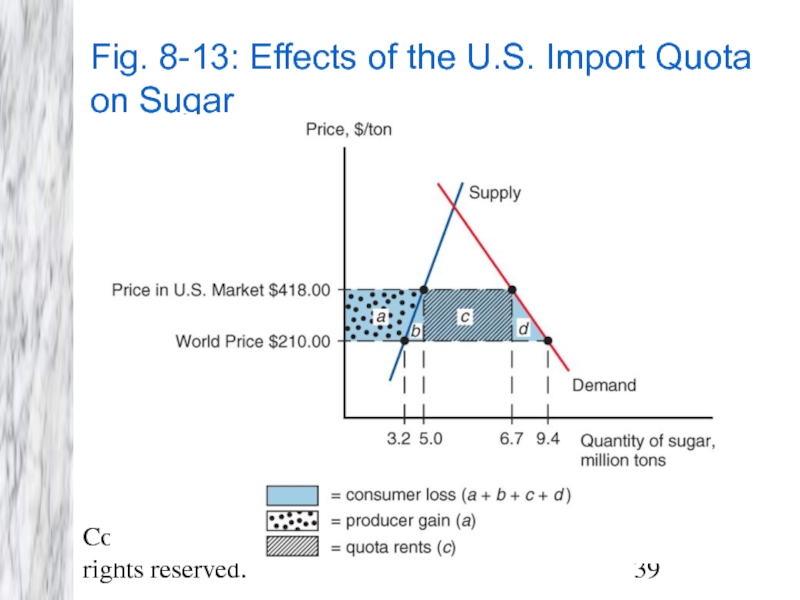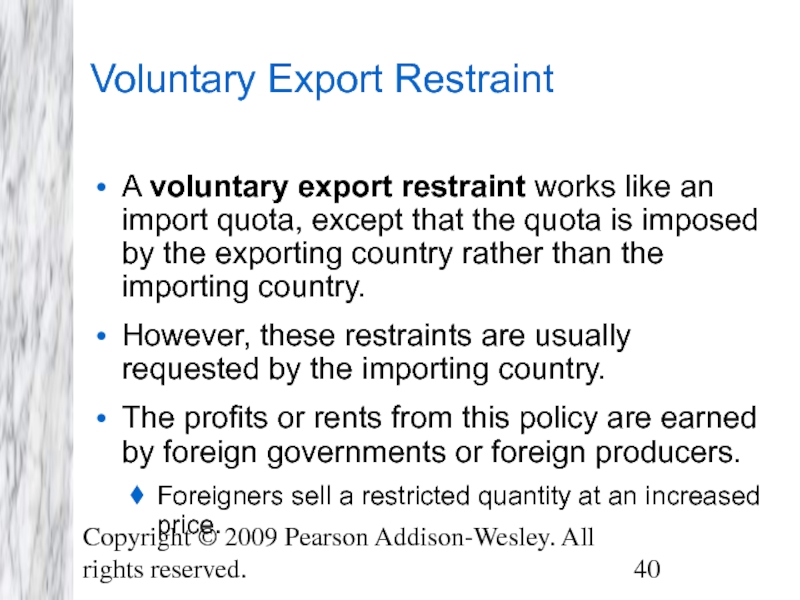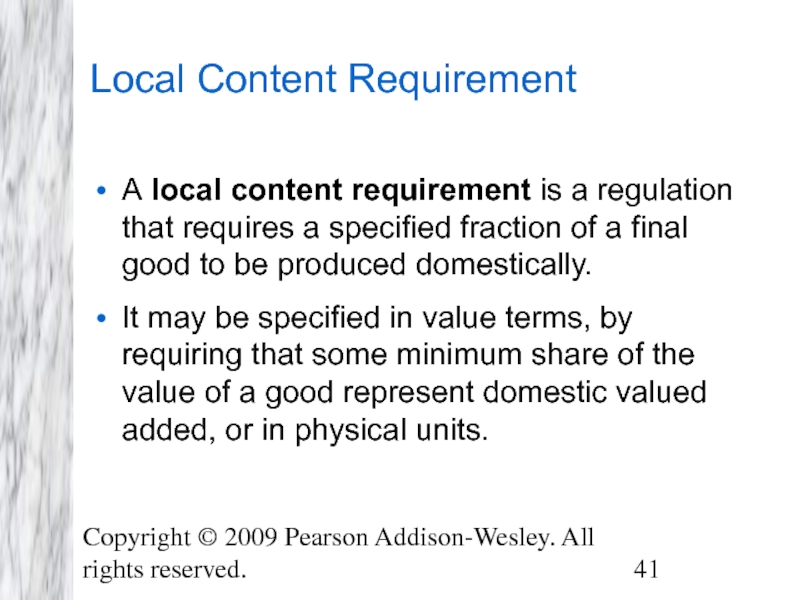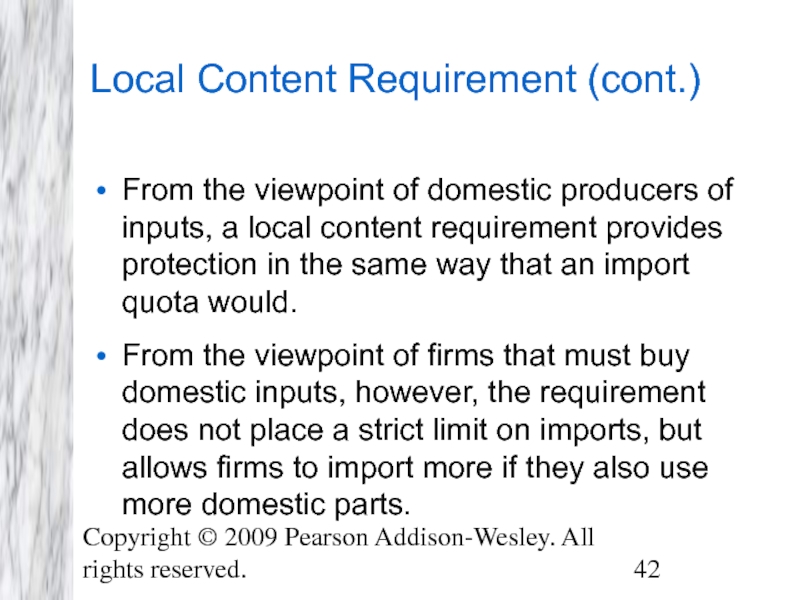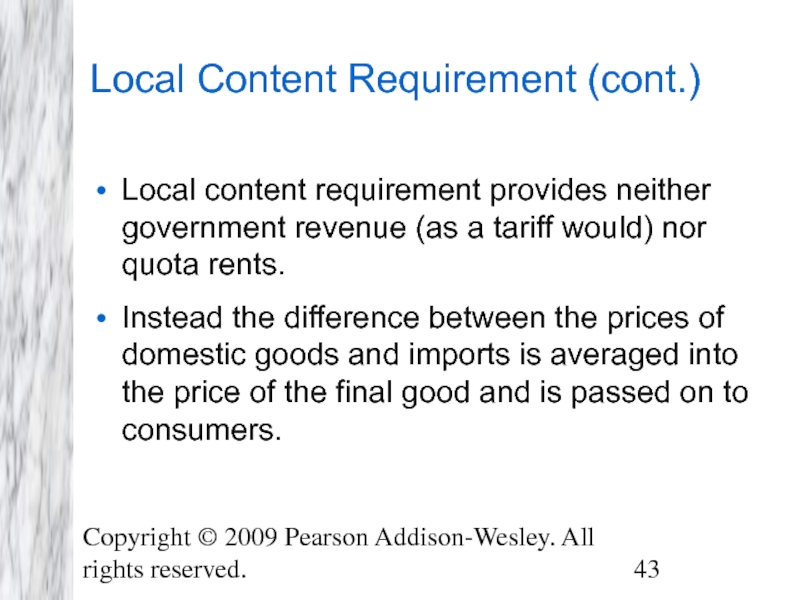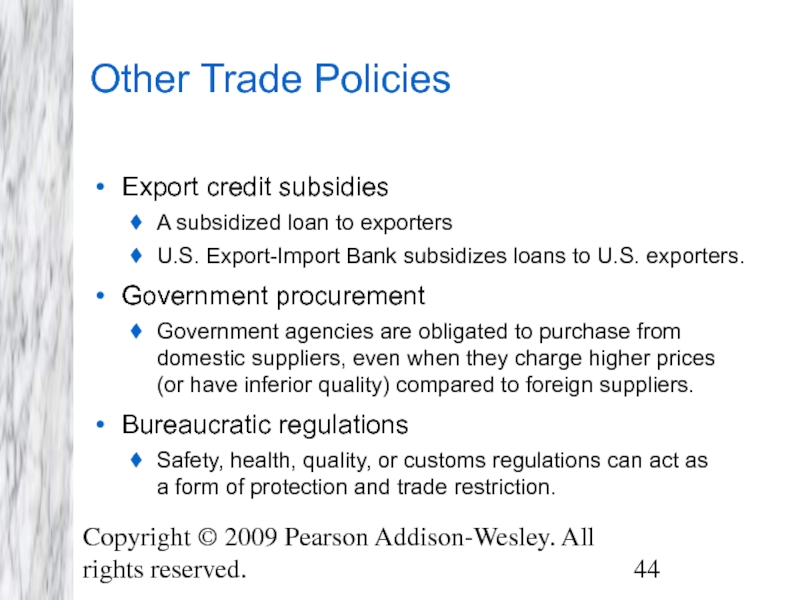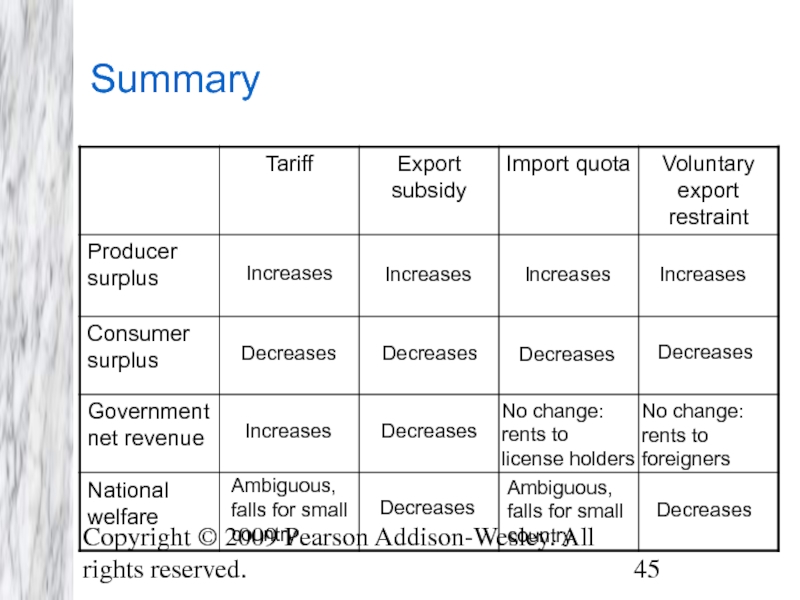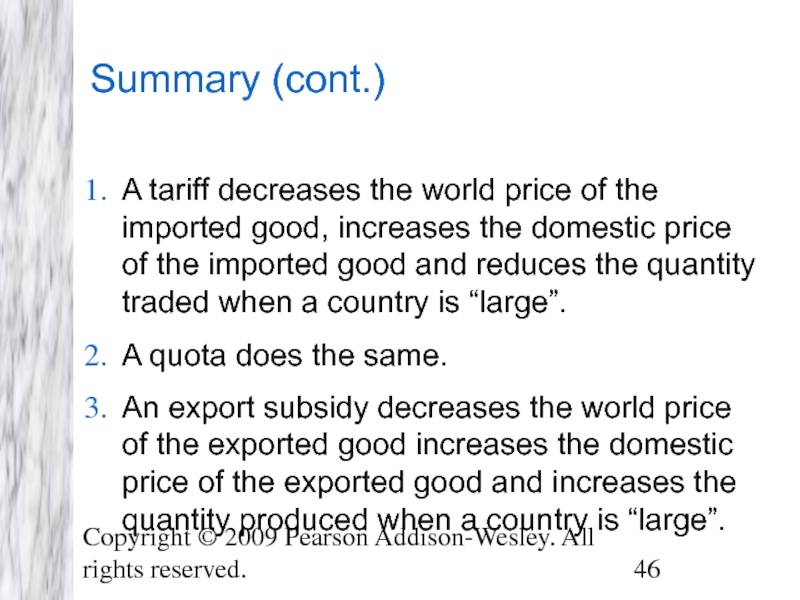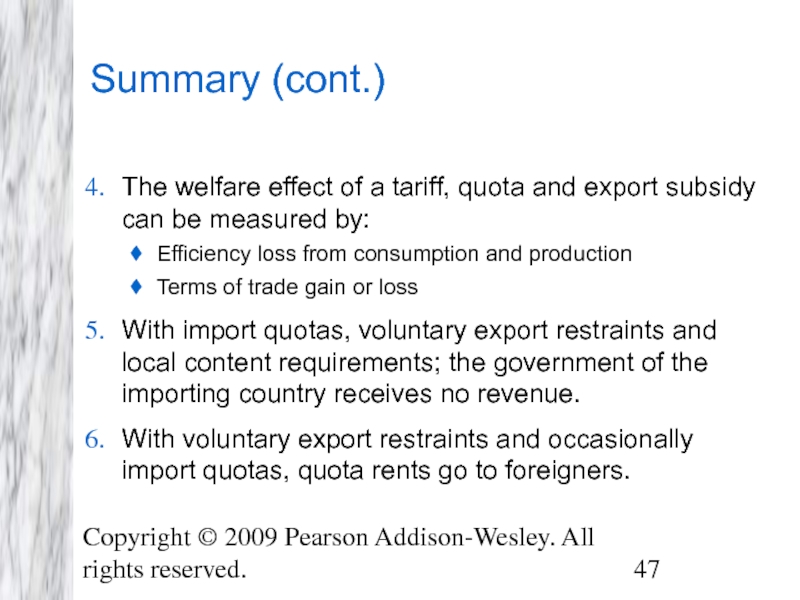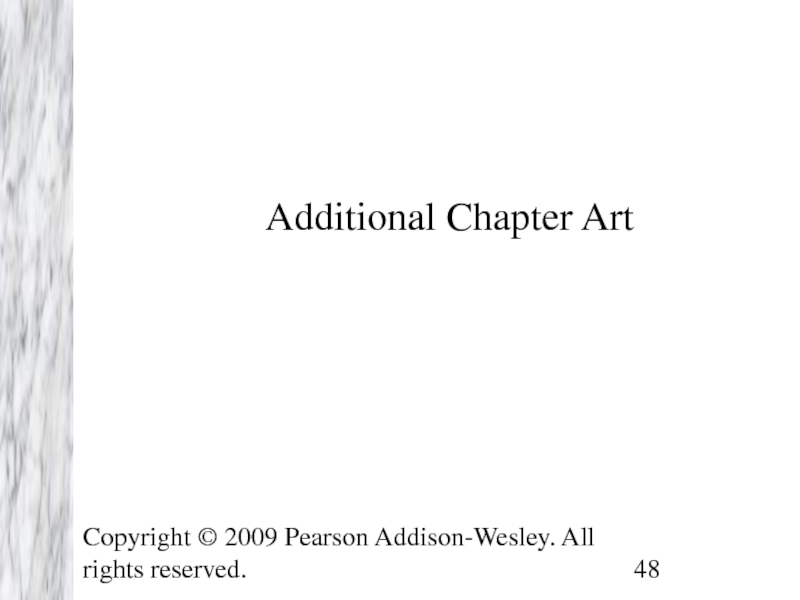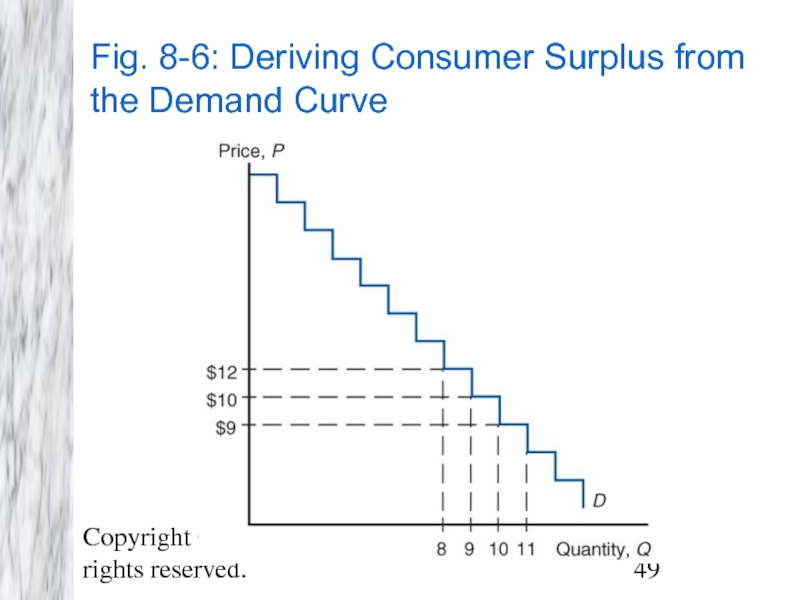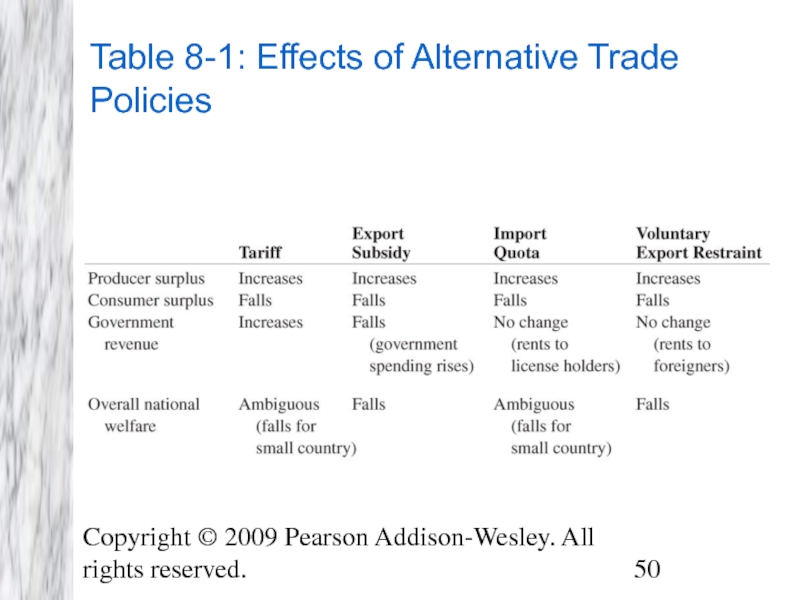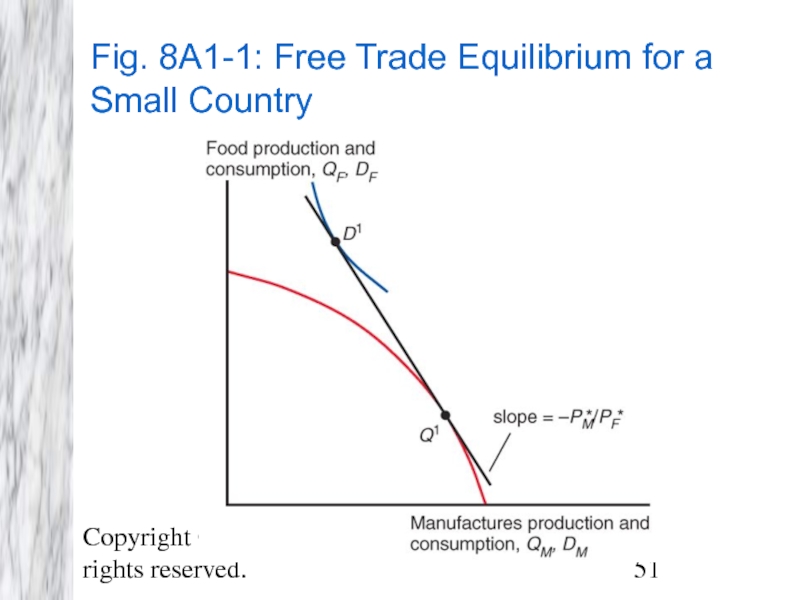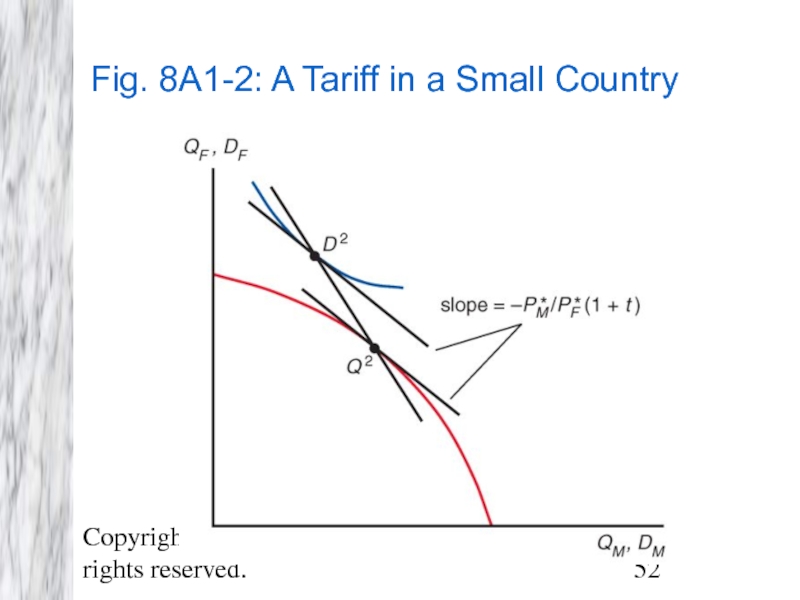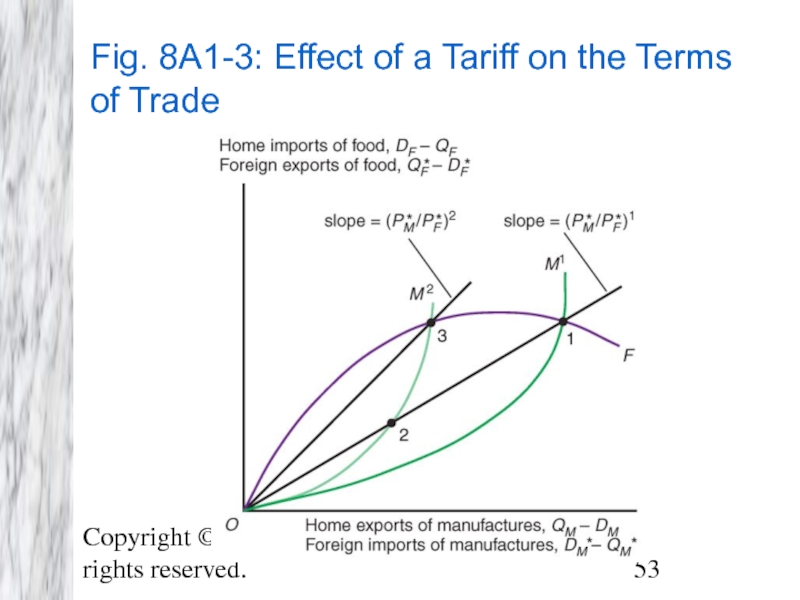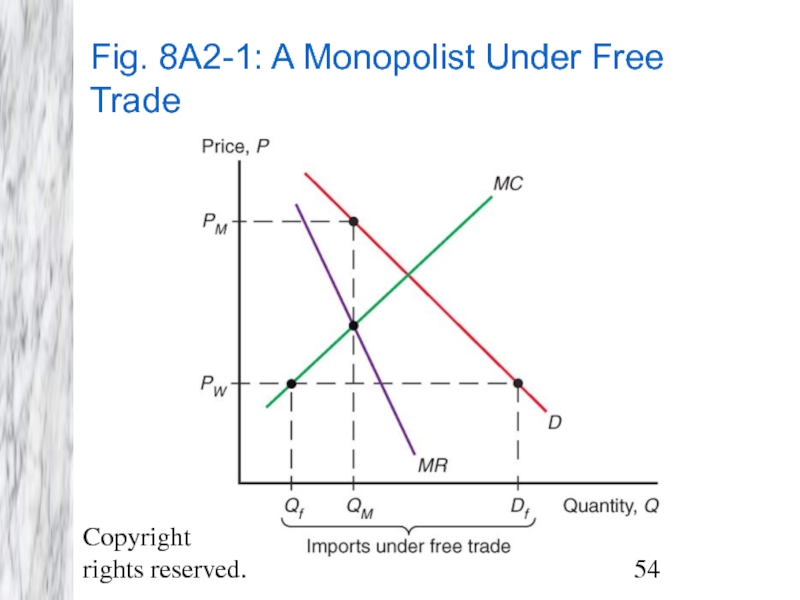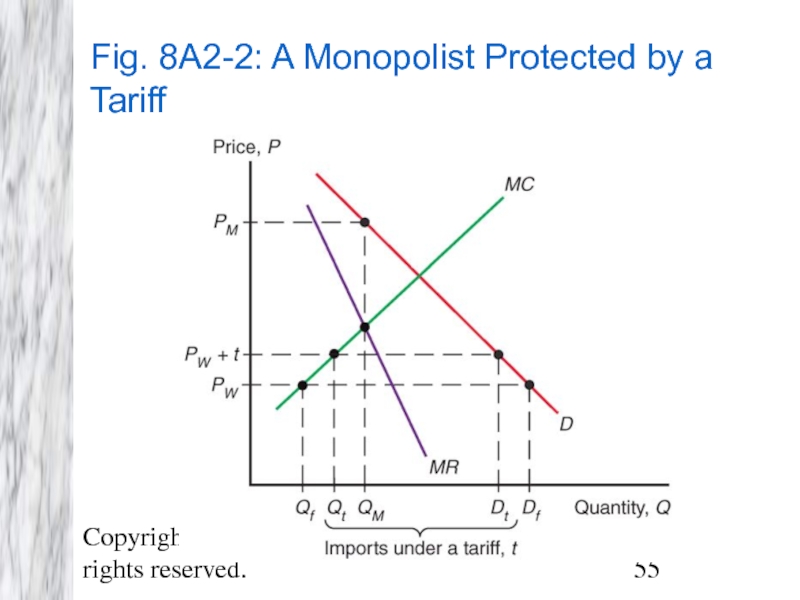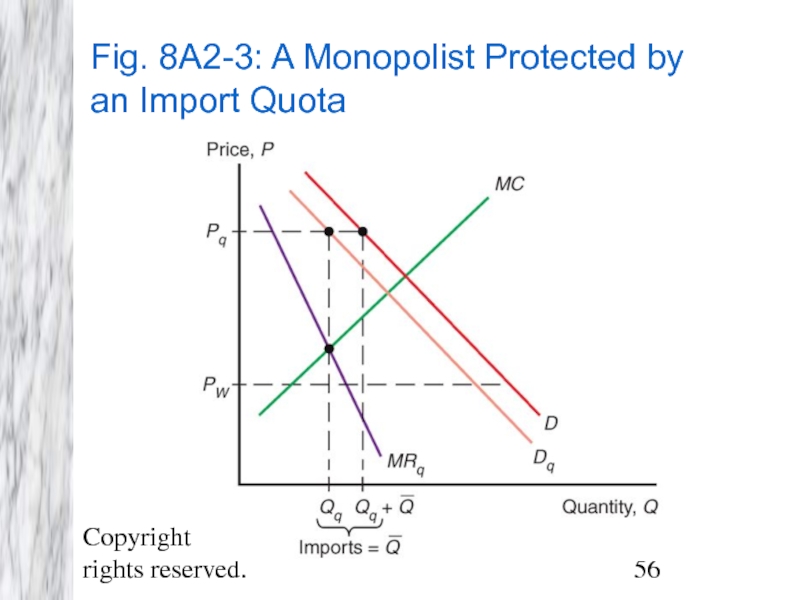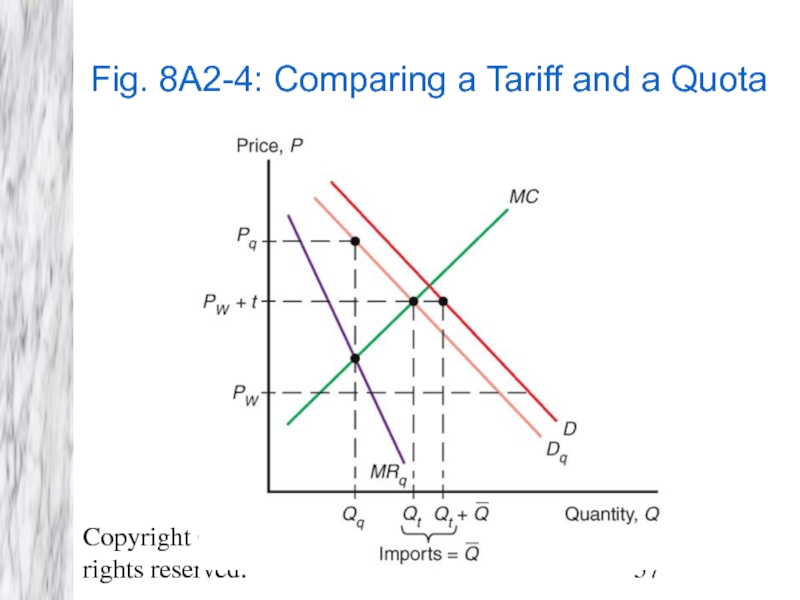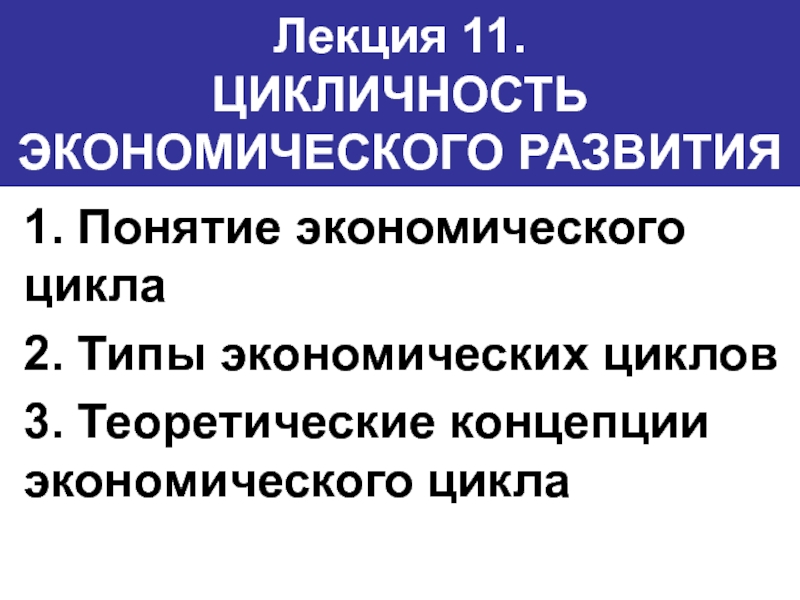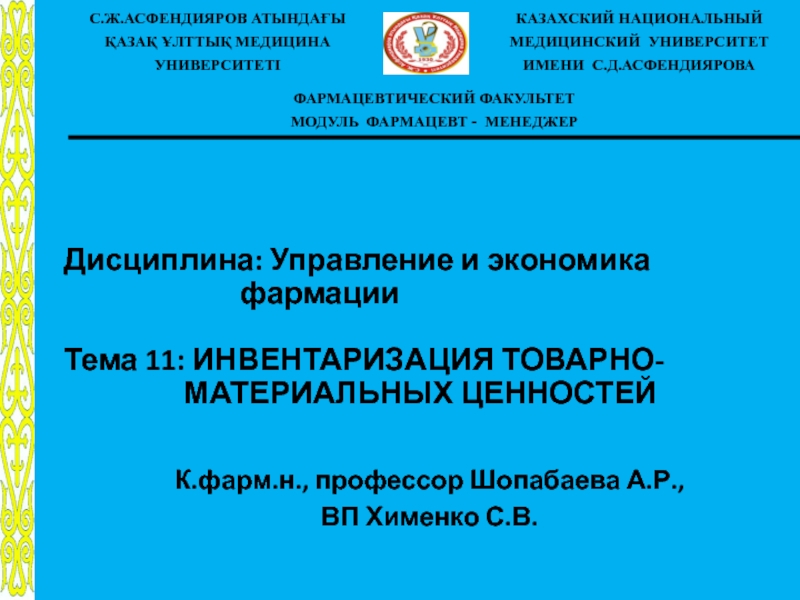- Главная
- Разное
- Дизайн
- Бизнес и предпринимательство
- Аналитика
- Образование
- Развлечения
- Красота и здоровье
- Финансы
- Государство
- Путешествия
- Спорт
- Недвижимость
- Армия
- Графика
- Культурология
- Еда и кулинария
- Лингвистика
- Английский язык
- Астрономия
- Алгебра
- Биология
- География
- Детские презентации
- Информатика
- История
- Литература
- Маркетинг
- Математика
- Медицина
- Менеджмент
- Музыка
- МХК
- Немецкий язык
- ОБЖ
- Обществознание
- Окружающий мир
- Педагогика
- Русский язык
- Технология
- Физика
- Философия
- Химия
- Шаблоны, картинки для презентаций
- Экология
- Экономика
- Юриспруденция
The Instruments of Trade Policy презентация
Содержание
- 1. The Instruments of Trade Policy
- 2. Copyright © 2009 Pearson Addison-Wesley. All rights
- 3. Copyright © 2009 Pearson Addison-Wesley. All rights
- 4. Copyright © 2009 Pearson Addison-Wesley. All rights
- 5. Copyright © 2009 Pearson Addison-Wesley. All rights
- 6. Copyright © 2009 Pearson Addison-Wesley. All rights reserved. Fig. 8-1: Deriving Home’s Import Demand Curve
- 7. Copyright © 2009 Pearson Addison-Wesley. All rights reserved. Fig. 8-2: Deriving Foreign’s Export Supply Curve
- 8. Copyright © 2009 Pearson Addison-Wesley. All rights
- 9. Copyright © 2009 Pearson Addison-Wesley. All rights reserved. Fig. 8-3: World Equilibrium
- 10. Copyright © 2009 Pearson Addison-Wesley. All rights
- 11. Copyright © 2009 Pearson Addison-Wesley. All rights
- 12. Copyright © 2009 Pearson Addison-Wesley. All rights reserved. Fig. 8-4: Effects of a Tariff
- 13. Copyright © 2009 Pearson Addison-Wesley. All rights
- 14. Copyright © 2009 Pearson Addison-Wesley. All rights
- 15. Copyright © 2009 Pearson Addison-Wesley. All rights
- 16. Copyright © 2009 Pearson Addison-Wesley. All rights
- 17. Copyright © 2009 Pearson Addison-Wesley. All rights
- 18. Copyright © 2009 Pearson Addison-Wesley. All rights
- 19. Copyright © 2009 Pearson Addison-Wesley. All rights
- 20. Copyright © 2009 Pearson Addison-Wesley. All rights
- 21. Copyright © 2009 Pearson Addison-Wesley. All rights
- 22. Copyright © 2009 Pearson Addison-Wesley. All rights reserved. Fig. 8-7: Geometry of Consumer Surplus
- 23. Copyright © 2009 Pearson Addison-Wesley. All rights
- 24. Copyright © 2009 Pearson Addison-Wesley. All rights reserved. Fig. 8-8: Geometry of Producer Surplus
- 25. Copyright © 2009 Pearson Addison-Wesley. All rights
- 26. Copyright © 2009 Pearson Addison-Wesley. All rights
- 27. Copyright © 2009 Pearson Addison-Wesley. All rights
- 28. Copyright © 2009 Pearson Addison-Wesley. All rights
- 29. Copyright © 2009 Pearson Addison-Wesley. All rights
- 30. Copyright © 2009 Pearson Addison-Wesley. All rights
- 31. Copyright © 2009 Pearson Addison-Wesley. All rights
- 32. Copyright © 2009 Pearson Addison-Wesley. All rights
- 33. Copyright © 2009 Pearson Addison-Wesley. All rights reserved. Fig. 8-11: Effects of an Export Subsidy
- 34. Copyright © 2009 Pearson Addison-Wesley. All rights
- 35. Copyright © 2009 Pearson Addison-Wesley. All rights
- 36. Copyright © 2009 Pearson Addison-Wesley. All rights reserved. Fig. 8-12: Europe’s Common Agricultural Program
- 37. Copyright © 2009 Pearson Addison-Wesley. All rights
- 38. Copyright © 2009 Pearson Addison-Wesley. All rights
- 39. Copyright © 2009 Pearson Addison-Wesley. All rights
- 40. Copyright © 2009 Pearson Addison-Wesley. All rights
- 41. Copyright © 2009 Pearson Addison-Wesley. All rights
- 42. Copyright © 2009 Pearson Addison-Wesley. All rights
- 43. Copyright © 2009 Pearson Addison-Wesley. All rights
- 44. Copyright © 2009 Pearson Addison-Wesley. All rights
- 45. Copyright © 2009 Pearson Addison-Wesley. All rights
- 46. Copyright © 2009 Pearson Addison-Wesley. All rights
- 47. Copyright © 2009 Pearson Addison-Wesley. All rights
- 48. Copyright © 2009 Pearson Addison-Wesley. All rights reserved. Additional Chapter Art
- 49. Copyright © 2009 Pearson Addison-Wesley. All rights
- 50. Copyright © 2009 Pearson Addison-Wesley. All rights reserved. Table 8-1: Effects of Alternative Trade Policies
- 51. Copyright © 2009 Pearson Addison-Wesley. All rights
- 52. Copyright © 2009 Pearson Addison-Wesley. All rights
- 53. Copyright © 2009 Pearson Addison-Wesley. All rights
- 54. Copyright © 2009 Pearson Addison-Wesley. All rights reserved. Fig. 8A2-1: A Monopolist Under Free Trade
- 55. Copyright © 2009 Pearson Addison-Wesley. All rights
- 56. Copyright © 2009 Pearson Addison-Wesley. All rights
- 57. Copyright © 2009 Pearson Addison-Wesley. All rights
Слайд 2Copyright © 2009 Pearson Addison-Wesley. All rights reserved.
Preview
Partial equilibrium analysis of
Costs and benefits of tariffs
Export subsidies
Import quotas
Voluntary export restraints
Local content requirements
Слайд 3Copyright © 2009 Pearson Addison-Wesley. All rights reserved.
Types of Tariffs
A specific
For example, $1 per kg of cheese
An ad valorem tariff is levied as a fraction of the value of imported goods.
For example, 25% tariff on the value of imported cars.
Let’s analyze how tariffs affect the economy.
Слайд 4Copyright © 2009 Pearson Addison-Wesley. All rights reserved.
Supply, Demand, and Trade
Let’s construct a model measuring how a tariff affects a single market, say that of wheat.
Suppose that in the absence of trade the price of wheat in the foreign country is lower than that in the domestic country.
With trade the foreign country will export: construct an export supply curve
With trade the domestic country will import: construct an import demand curve
Слайд 5Copyright © 2009 Pearson Addison-Wesley. All rights reserved.
Supply, Demand, and Trade
An export supply curve is the difference between the quantity that foreign producers supply minus the quantity that foreign consumers demand, at each price.
An import demand curve is the difference between the quantity that domestic consumers demand minus the quantity that domestic producers supply, at each price.
Слайд 6Copyright © 2009 Pearson Addison-Wesley. All rights reserved.
Fig. 8-1: Deriving Home’s
Слайд 7Copyright © 2009 Pearson Addison-Wesley. All rights reserved.
Fig. 8-2: Deriving Foreign’s
Слайд 8Copyright © 2009 Pearson Addison-Wesley. All rights reserved.
Supply, Demand, and Trade
In equilibrium, the quantities of
import demand = export supply
domestic demand – domestic supply =
foreign supply – foreign demand
In equilibrium, the quantities of
world demand = world supply
Слайд 10Copyright © 2009 Pearson Addison-Wesley. All rights reserved.
The Effects of a
A tariff can be viewed as an added cost of transportation, making sellers unwilling to ship goods unless the price difference between the domestic and foreign markets exceeds the tariff.
If sellers are unwilling to ship wheat, there is excess demand for wheat in the domestic market and excess supply in the foreign market.
The price of wheat will tend to rise in the domestic market.
The price of wheat will tend to fall in the foreign market.
Слайд 11Copyright © 2009 Pearson Addison-Wesley. All rights reserved.
The Effects of a
Thus, a tariff will make the price of a good rise in the domestic market and will make it fall in the foreign market, until the price difference equals the tariff.
PT – P*T = t
PT = P*T + t
The price of the good in foreign (world) markets should fall if there is a significant drop in the quantity demanded of the good caused by the domestic tariff.
Слайд 13Copyright © 2009 Pearson Addison-Wesley. All rights reserved.
The Effects of a
Because the price in domestic markets rises (to PT), domestic producers should supply more and domestic consumers should demand less.
The quantity of imports falls from QW to QT
Because the price in foreign markets falls (to P*T), foreign producers should supply less and foreign consumers should demand more.
The quantity of exports falls from QW to QT
Слайд 14Copyright © 2009 Pearson Addison-Wesley. All rights reserved.
The Effects of a
The quantity of domestic import demand equals the quantity of foreign export supply when PT – P*T = t
In this case, the increase in the price of the good in the domestic country is less than the amount of the tariff.
Part of the effect of the tariff causes the foreign country’s export price to decline, and thus is not passed on to domestic consumers.
But this effect is sometimes not very significant:
Слайд 15Copyright © 2009 Pearson Addison-Wesley. All rights reserved.
The Effects of a
When a country is “small,” it has no effect on the foreign (world) price of a good, because its demand of the good is an insignificant part of world demand.
Therefore, the foreign price will not fall, but will remain at Pw
The price in the domestic market, however, will rise to PT = Pw + t
Слайд 16Copyright © 2009 Pearson Addison-Wesley. All rights reserved.
Fig. 8-5: A Tariff
Слайд 17Copyright © 2009 Pearson Addison-Wesley. All rights reserved.
Effective Rate of Protection
The
It represents the change in value that firms in an industry add to the production process when trade policy changes.
The change in value that firms in an industry provide depends on the change in prices when trade policies change.
Effective rates of protection often differ from tariff rates because tariffs affect sectors other than the protected sector, causing indirect effects on the prices and value added for the protected sector.
Слайд 18Copyright © 2009 Pearson Addison-Wesley. All rights reserved.
Effective Rate of Protection
For example, suppose that automobiles sell in world markets for $8,000, and they are made from factors of production worth $6,000.
The value added of the production process is
$8,000-$6,000
Suppose that a country puts a 25% tariff on imported autos so that domestic auto assembly firms can now charge up to $10,000 instead of $8,000.
Auto assembly will occur in the domestic country if the value added is at least $10,000-$6,000.
Слайд 19Copyright © 2009 Pearson Addison-Wesley. All rights reserved.
Effective Rate of Protection
The effective rate of protection for domestic auto assembly firms is the change in value added:
($4,000 - $2,000)/$2,000 = 100%
In this case, the effective rate of protection is greater than the tariff rate.
Слайд 20Copyright © 2009 Pearson Addison-Wesley. All rights reserved.
Costs and Benefits of
A tariff raises the price of a good in the importing country, so we expect it to hurt consumers and benefit producers there.
In addition, the government gains tariff revenue from a tariff.
How to measure these costs and benefits?
We use the concepts of consumer surplus and producer surplus.
Слайд 21Copyright © 2009 Pearson Addison-Wesley. All rights reserved.
Consumer Surplus
Consumer surplus measures
The maximum price each would be willing to pay is determined by a demand (willingness to buy) function.
When the price increases, the quantity demanded decreases as well as the consumer surplus.
Слайд 22Copyright © 2009 Pearson Addison-Wesley. All rights reserved.
Fig. 8-7: Geometry of
Слайд 23Copyright © 2009 Pearson Addison-Wesley. All rights reserved.
Producer Surplus
Producer surplus measures
The minimum price each would be willing to sell at is determined by a supply (willingness to sell) function.
When price increases, the quantity supplied increases as well as the producer surplus.
Слайд 24Copyright © 2009 Pearson Addison-Wesley. All rights reserved.
Fig. 8-8: Geometry of
Слайд 25Copyright © 2009 Pearson Addison-Wesley. All rights reserved.
Costs and Benefits of
A tariff raises the price of a good in the importing country, making its consumer surplus decrease (making its consumers worse off) and making its producer surplus increase (making its producers better off).
Also, government revenue will increase.
Слайд 26Copyright © 2009 Pearson Addison-Wesley. All rights reserved.
Fig. 8-9: Costs and
Слайд 27Copyright © 2009 Pearson Addison-Wesley. All rights reserved.
Costs and Benefits of
For a “large” country, whose imports and exports can affect foreign (world) prices, the welfare effect of a tariff is ambiguous.
The triangles b and d represent the efficiency loss.
The tariff distorts production and consumption decisions: producers produce too much and consumers consume too little compared to the market outcome.
The rectangle e represents the terms of trade gain.
The terms of trade increases because the tariff lowers foreign export (domestic import) prices.
Слайд 28Copyright © 2009 Pearson Addison-Wesley. All rights reserved.
Costs and Benefits of
Government revenue from the tariff equals the tariff rate times the quantity of imports.
t = PT – P*T
QT = D2 – S2
Government revenue = t x QT = c + e
Part of government revenue (rectangle e) represents the terms of trade gain, and part (rectangle c) represents part of the value of lost consumer surplus.
The government gains at the expense of consumers and foreigners.
Слайд 29Copyright © 2009 Pearson Addison-Wesley. All rights reserved.
Costs and Benefits of
If the terms of trade gain exceeds the efficiency loss, then national welfare will increase under a tariff, at the expense of foreign countries.
However, this analysis assumes that the terms of trade does not change due to tariff changes by foreign countries (that is, due to retaliation).
Слайд 30Copyright © 2009 Pearson Addison-Wesley. All rights reserved.
Fig. 8-10: Net Welfare
Слайд 31Copyright © 2009 Pearson Addison-Wesley. All rights reserved.
Export Subsidy
An export subsidy
A specific subsidy is a payment per unit exported.
An ad valorem subsidy is a payment as a proportion of the value exported.
An export subsidy raises the price of a good in the exporting country, decreasing its consumer surplus (making its consumers worse off) and increasing its producer surplus (making its producers better off).
Also, government revenue will decrease.
Слайд 32Copyright © 2009 Pearson Addison-Wesley. All rights reserved.
Export Subsidy (cont.)
An export
In contrast to a tariff, an export subsidy worsens the terms of trade by lowering the price of domestic products in world markets.
Слайд 33Copyright © 2009 Pearson Addison-Wesley. All rights reserved.
Fig. 8-11: Effects of
Слайд 34Copyright © 2009 Pearson Addison-Wesley. All rights reserved.
Export Subsidy (cont.)
An export
The triangles b and d represent the efficiency loss.
The subsidy distorts production and consumption decisions: producers produce too much and consumers consume too little compared to the market outcome.
The area b + c + d + f + g represents the cost of government subsidy.
In addition, the terms of trade decreases, because the price of exports falls in foreign markets to P*s.
Слайд 35Copyright © 2009 Pearson Addison-Wesley. All rights reserved.
Export Subsidy in Europe
The
The subsidized exports reduce world prices of agricultural products.
The direct cost of this policy for European taxpayers is almost $50 billion.
But the EU has proposed that farmers receive direct payments independent of the amount of production to help lower EU prices and reduce production.
Слайд 36Copyright © 2009 Pearson Addison-Wesley. All rights reserved.
Fig. 8-12: Europe’s Common
Слайд 37Copyright © 2009 Pearson Addison-Wesley. All rights reserved.
Import Quota
An import quota
This restriction is usually enforced by issuing licenses to domestic firms that import, or in some cases to foreign governments of exporting countries.
A binding import quota will push up the price of the import because the quantity demanded will exceed the quantity supplied by domestic producers and from imports.
Слайд 38Copyright © 2009 Pearson Addison-Wesley. All rights reserved.
Import Quota (cont.)
When a
Instead, the revenue from selling imports at high prices goes to quota license holders: either domestic firms or foreign governments.
These extra revenues are called quota rents.
Слайд 39Copyright © 2009 Pearson Addison-Wesley. All rights reserved.
Fig. 8-13: Effects of
Слайд 40Copyright © 2009 Pearson Addison-Wesley. All rights reserved.
Voluntary Export Restraint
A voluntary
However, these restraints are usually requested by the importing country.
The profits or rents from this policy are earned by foreign governments or foreign producers.
Foreigners sell a restricted quantity at an increased price.
Слайд 41Copyright © 2009 Pearson Addison-Wesley. All rights reserved.
Local Content Requirement
A local
It may be specified in value terms, by requiring that some minimum share of the value of a good represent domestic valued added, or in physical units.
Слайд 42Copyright © 2009 Pearson Addison-Wesley. All rights reserved.
Local Content Requirement (cont.)
From
From the viewpoint of firms that must buy domestic inputs, however, the requirement does not place a strict limit on imports, but allows firms to import more if they also use more domestic parts.
Слайд 43Copyright © 2009 Pearson Addison-Wesley. All rights reserved.
Local Content Requirement (cont.)
Local
Instead the difference between the prices of domestic goods and imports is averaged into the price of the final good and is passed on to consumers.
Слайд 44Copyright © 2009 Pearson Addison-Wesley. All rights reserved.
Other Trade Policies
Export credit
A subsidized loan to exporters
U.S. Export-Import Bank subsidizes loans to U.S. exporters.
Government procurement
Government agencies are obligated to purchase from domestic suppliers, even when they charge higher prices (or have inferior quality) compared to foreign suppliers.
Bureaucratic regulations
Safety, health, quality, or customs regulations can act as a form of protection and trade restriction.
Слайд 45Copyright © 2009 Pearson Addison-Wesley. All rights reserved.
Summary
Increases
Increases
Increases
Increases
No change:
rents to
license
Increases
Decreases
Decreases
Decreases
Decreases
Decreases
No change:
rents to
foreigners
Ambiguous,
falls for small
country
Ambiguous,
falls for small
country
Decreases
Decreases
Слайд 46Copyright © 2009 Pearson Addison-Wesley. All rights reserved.
Summary (cont.)
A tariff decreases
A quota does the same.
An export subsidy decreases the world price of the exported good increases the domestic price of the exported good and increases the quantity produced when a country is “large”.
Слайд 47Copyright © 2009 Pearson Addison-Wesley. All rights reserved.
Summary (cont.)
The welfare effect
Efficiency loss from consumption and production
Terms of trade gain or loss
With import quotas, voluntary export restraints and local content requirements; the government of the importing country receives no revenue.
With voluntary export restraints and occasionally import quotas, quota rents go to foreigners.
